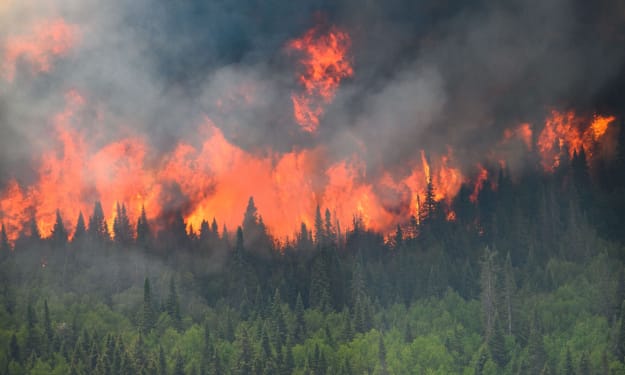
Climate change is one of the most pressing global environmental challenges of our time, and it has already caused irreversible damage to our planet. Climate change, also known as global warming, is the long-term increase in the average temperature of the Earth's climate system. It is caused by both natural and human-induced processes. Natural causes of climate change include volcanic eruptions, El Niño and La Niña, and shifts in the Earth's orbit. Human-induced causes of climate change include increases in atmospheric carbon dioxide, nitrous oxide, and other gases associated with human activity, such as burning fossil fuels and deforestation.
Climate change has wide-reaching impacts on our environment and way of life. It has caused global sea levels to rise, changed rainfall patterns, decreased the amount of Arctic sea ice, and even affected the migration of various species of animals. In addition, climate change has led to extended droughts, an increase in the frequency of extreme weather events, and a higher likelihood of floods and hurricanes.
These changes have drastic implications for human health, livelihoods, and ecosystems. High temperatures create a greater risk of heat stroke and other dangerous heat-related illnesses, while changes in precipitation patterns make it difficult for farmers to plan their crop growth and for rural communities to predict how much water they can expect. Combined, these impacts put communities, particularly those in developing countries, at greater risk of poverty and hunger.
At the same time, climate change is putting immense pressure on ecosystems. Increased temperatures and more variable precipitation patterns make it difficult for species to adapt and shift to their ideal habitats. Climate change has also contributed to an increase in the frequency and intensity of wildfires, resulting in the loss of large swaths of wild areas. Furthermore, warmer temperatures are causing ocean levels to rise, which can cause coastal and island communities to become more vulnerable to rising tides, floods, and storm surges.
In order to mitigate the effects of climate change, it is essential that governments, businesses, and individuals act now to reduce emissions. This can include implementing new energy-efficient infrastructure, switching to renewable energy sources, and transitioning to more sustainable transportation methods. It also involves engaging in dialogue with our neighbours and the international community to create collective strategies that focus on reducing emissions and protecting the environment.
We have a moral responsibility to safeguarding the environment for future generations. Climate change affects everyone and the consequences of inaction will continue to be felt for years to come. This means taking urgent action and creating a shared sense of accountability is essential in order to build a safe and sustainable future. Acting now to reduce emissions can ensure that the world continues to be a livable, healthy, and vibrant place for generations to come.
Climate, by definition, is the average weather conditions in a given location over a long period of time. Everyone knows that the climate can vary from place to place, but there are actually seven distinct types of climates found on our planet.
1. Tropical Climates
Tropical climates are characterized by consistently warm temperatures and lots of rainfall. Locations with a tropical climate generally don't have much variation in temperature between seasons; they can range from hot and humid to warm and dry. Examples of areas with a tropical climate are Brazil, India, Indonesia, Cape Verde, Thailand, and the Democratic Republic of the Congo.
2. Temperate Climates
Temperate climates are found between the tropics and the polar regions. This climate is characterized by both warm summers and cooler winters. These climates allow for the growth of a wide variety of plants and animals. Examples of areas with a temperate climate are much of Europe, the United States, China, and Australia.
3. Mediterranean Climates
The Mediterranean climate is found most often near the Mediterranean Sea, but it can also be found in other regions, such as California. This climate is characterized by warm, dry summers and cooler, wet winters. The Mediterranean climate is ideal for growing citrus fruits, olives, and other crops.
4. Arid Climates
An arid climate is one that is characterized by very little precipitation and very high temperatures. Arid climates are found in deserts and are not suitable for agriculture. Examples of areas with an arid climate are the Sahara Desert, the Arabian Desert, and the Gobi Desert.
5. Tundra Climates
Tundra climates are found in the coldest regions of the world. These areas are characterized by very cold temperatures and very little precipitation. Because of the cold temperatures, only a few species of plants and animals can survive in these areas. Examples of tundra climates can be found in the Arctic regions of the United States, Canada, and Russia.
6. Polar Climates
Polar climates are similar to tundra climates, but they are even colder. These climates occur in the coldest regions of the world and are characterized by temperatures that are below freezing year round. Examples of polar climates are Antarctica, Greenland, and much of the Arctic.
7. Subpolar Oceanic Climates
Subpolar oceanic climates are found between the polar and temperate climates and are usually found in areas with cool summers and cold winters. These climates are characterized by lots of precipitation and mild temperatures. Examples of areas with a subpolar oceanic climate are Norway, Scotland, and parts of Alaska.
Each of these seven climates has its own unique characteristics and can be experienced in different parts of the world. Each of these climates can affect the plants, animals, and people that live in them, so it is important to be aware of the climate of a given area in order to better understand the living conditions and environment. Whether it's a tropical climate in the Amazon rainforest or a tundra climate in the Arctic, all of these climates play an important role in shaping the world we live in today.





Comments
There are no comments for this story
Be the first to respond and start the conversation.